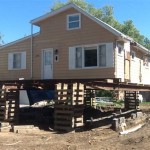What To Do If Your Basement Starts Flooding
A flooded basement is a homeowner's nightmare. It can cause significant damage to your belongings, your home's structure, and your health. Flooding can be caused by a variety of factors, including heavy rain, snowmelt, overflowing sewers, and even broken pipes. However, understanding what to do when your basement starts flooding can help minimize the damage and make the cleanup process more manageable.
Assess the Situation and Take Immediate Steps
The first step is to assess the situation and take immediate steps to prevent further damage. This includes identifying the source of the water, if possible, and taking steps to stop it. If you suspect a broken pipe, the water supply should be shut off immediately. If the flood is caused by heavy rainfall, ensure downspouts are directed away from the foundation and that any standing water is channeled away from the house. If the flooding is due to an overflowing sewer, contact your local sanitation department immediately.
If the water level is rising quickly, take steps to protect yourself and your family. If the floodwaters are deep enough to reach electrical outlets, unplug all appliances. You should also be aware of the potential for sewage contamination if the water is from a sewer backup. It's crucial to avoid contact with sewage, and if you do come into contact, wash thoroughly with soap and water. In the event of significant flooding or if you suspect sewage contamination, it's best to contact your local emergency services for assistance.
Safely Remove Water and Damaged Items
Once the water source is identified and stopped, the next step is to remove the water from the basement. If the water level is shallow enough, you may be able to remove it with a pump. If the water level is deeper, you may need to call a professional water extraction company. Any standing water should be removed as quickly as possible to minimize the damage to the structure and your belongings. You should also begin removing any damaged items from the basement as soon as possible. If the items are saturated with water, they should be disposed of properly to prevent mold growth.
Before removing any items, it's important to assess the damage. Items that have been soaked in water for an extended period may be unsalvageable, and it's best to dispose of them to avoid mold growth. Items that can be salvaged should be dried thoroughly and cleaned with a disinfectant to prevent the growth of bacteria and mildew. You can use fans and dehumidifiers to speed up the drying process. It's also important to ensure that the basement is properly ventilated to prevent moisture from becoming trapped.
Repair and Restoration
Once the water is removed and the damaged items have been taken care of, the next step is to repair and restore the basement. This may involve cleaning and disinfecting surfaces, replacing drywall, and repairing any structural damage. If the flooding was caused by sewage backup, you may need to have the sewage lines professionally cleaned and disinfected. This process requires professional assistance to ensure the safety of your home and family. Be sure to contact a licensed contractor familiar with water damage restoration for this task.
It's important to address the cause of the flooding to prevent it from happening again. This may involve installing a sump pump, repairing broken pipes, or improving drainage around the foundation. If you are unsure what to do, it's always best to consult with a professional. A certified contractor can assess the situation and recommend the best course of action.
Protecting Yourself from Future Flooding
Taking preventative measures is crucial in preventing future flooding. Regularly inspect your basement for signs of leaks or cracks. Ensure downspouts are directed away from the foundation and that the ground slopes away from your home to prevent water from pooling around the foundation. If you have a sump pump, make sure it is working properly and that it is regularly maintained. These steps can help minimize the risk of flooding and protect your home from significant damage.
In the event of a basement flood, it's important to act quickly and decisively. The steps outlined above will help you to minimize damage and protect your home. Remember, it's best to seek professional assistance if the flood is significant or if you are unsure how to proceed. A qualified professional can ensure that the restoration process is handled properly and that your home is safe.

What To Do If The Basement Floods A Step By Guide

Tips For Handling Water In Your Basement Zoeller At Home

6 Simple Ways To Prevent Basement Flooding American Dry

Handling Basement Flooding And Prevention

How To Clean A Flooded Basement News And Events For Systems Inc

Flooded Basement Cleaning Rapid Water Extraction Drying Service

Flooded Basement Cleanup Who To Hire And Steps Take Bob Vila

What To Do If Your Basement Floods Jenkins Restorations

Basement Flooding Will Become More Common With Global Warming

Five Tips For Preventing Basement Floods Before They Start
Related Posts







